|
Page A4 / The Joan
De Arc Crusader / Monday, December 25, 2023
Front Page
A1 /
Editorials A2 /
Nostalgia on the Avenue A3 /
Crossword
A5

The top five Saturday morning cartoons on Joan De Arc
By J. Bueker
Saturday
morning cartoons were the very quintessence of baby boomer childhood. After
a long, dreary week of bothersome school work, crabby teachers, demanding
parents and tedious household chores, this genuinely sacred interval of time
was our happy reward. While we seemed to have some difficulty awaking and
arising on school days, every Saturday morning without fail we were
cheerfully wide awake and warming up the TV at the crack of dawn, munching
away on a bowl of Cap’n Crunch in excited anticipation. Saturday morning
cartoons were nothing less than one of the supreme joys of being a boomer
kid.
One of the great things about being up
early on a Saturday was that our parents and older siblings were still in
bed snoring obliviously away, and so my brother Charles and I made the most
of this special time. I fondly recall one Saturday morning in the early Joan
De Arc years when we smuggled a few blankets into the family room so that
Charles the future engineer could devise and construct a sort of enclosed
tent-like theatrical structure that we sat inside to enhance our
cartoon-viewing experience. That’s right -- my brother and I were intrepid
pioneers of the home theater with surround sound.
For our purposes, “Saturday morning cartoons” shall be defined as a genre of
television programming comprised of animated kids shows that ran on the big
three networks on Saturdays in the 1960s from 6:00 am to 12 noon local time.
Please note that this definition therefore excludes such monumental programs
as Rocky and Bullwinkle,
which was a staple on Sunday mornings during those glorious years. That show
pretty much deserves its very own article anyway. Hell, Mr. Peabody and
Sherman alone merit their own article.
Many
memorable animated greats aired on Saturday morn during this period of
course and distilling the list down to a small pantheon is no easy task,
necessitating the omission of more than a few fond favorites. What follows
is my highly opinionated and open-to-revision Top 5 List of ‘60s Saturday
morning cartoons. I realize these sorts of lists are purely subjective and
ultimately rather annoying, but they do provide an all-too convenient
vehicle for wistfully nostalgic newspaper articles. So away we go:
5.
Jonny Quest
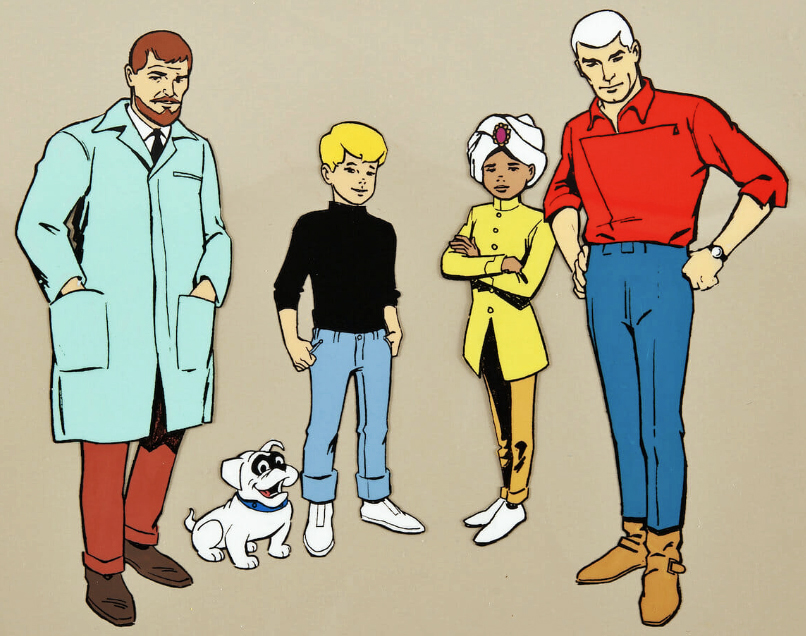 Jonny Quest
was aimed squarely at boomer boys and was widely regarded (at least by
boomer boys) as the coolest cartoon in the history of the known cosmos. This
Hanna-Barbera offering was
a marked contrast to most other Saturday morning fare as it was devoid of
goofy, exaggerated comic characters and rather presented relatively
realistic settings, relatable characters, and distinctively dramatic
storylines. Jonny Quest
was aimed squarely at boomer boys and was widely regarded (at least by
boomer boys) as the coolest cartoon in the history of the known cosmos. This
Hanna-Barbera offering was
a marked contrast to most other Saturday morning fare as it was devoid of
goofy, exaggerated comic characters and rather presented relatively
realistic settings, relatable characters, and distinctively dramatic
storylines.
Our hero Jonny is a markedly
precocious lad whose famous scientist father Benton Quest has a knack for
falling into incredible and dangerous adventures that invariably include
Jonny, his adoptive Indian brother Hadji, and their rugged bodyguard Race
Bannon. The team is rounded out by Jonny’s faithful pooch Bandit, who
interestingly was the only non-anthropomorphic canine in the Hanna-Barbera
cartoon universe.
The show combined science,
exotic locations, detective-style mysteries and imaginative villains into a
compelling weekly narrative. The Indian boy Hadji introduces an element of
eastern mysticism and magic to the proceedings, deftly blending the show’s
science fiction with the uncanny and supernatural. Of course, there are also
the cool monsters -- the gigantic one-eyed robotic spider attacking Dr.
Quest’s compound, which appeared in the show’s intro sequence each week,
remains an indelible image from my childhood.
4.
The Jetsons
The Jetsons
was a whimsical 1960’s peek into a future that has famously become
startlingly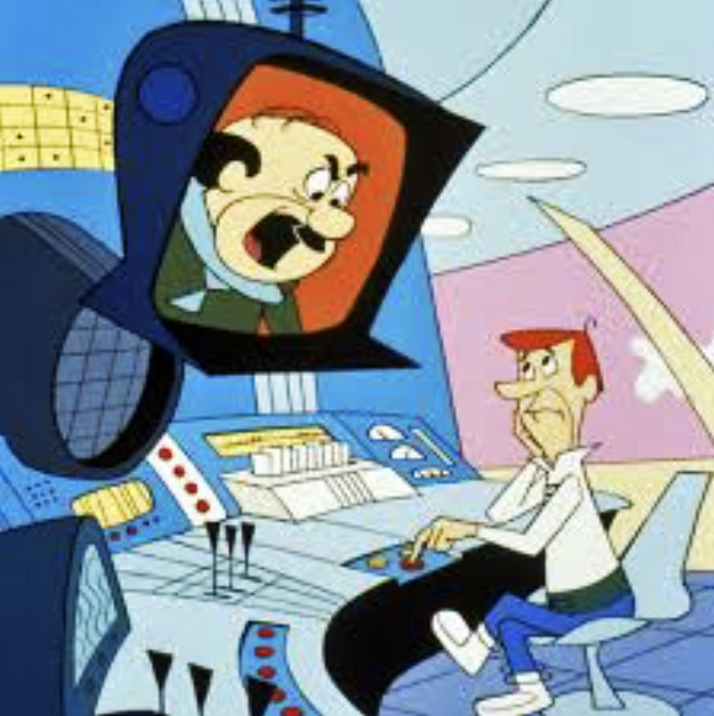 prophetic. The show seems to anticipate with remarkable
prescience such current technologies as housekeeper robots, personal video
conferencing, tablet computers, smart watches, holograms, and ubiquitous
giant flat-screen TVs, to name but a few. Yet despite its extraordinary
high-tech futuristic setting,
The Jetsons was in many ways
your typical sixties family sitcom: George goes to work for a tyrannical
boss, Jane his wife is a homemaker, daughter Judy a high school student, and
his boy Elroy a grade schooler. The stories were for the most part fairly
domestic and formulaic. prophetic. The show seems to anticipate with remarkable
prescience such current technologies as housekeeper robots, personal video
conferencing, tablet computers, smart watches, holograms, and ubiquitous
giant flat-screen TVs, to name but a few. Yet despite its extraordinary
high-tech futuristic setting,
The Jetsons was in many ways
your typical sixties family sitcom: George goes to work for a tyrannical
boss, Jane his wife is a homemaker, daughter Judy a high school student, and
his boy Elroy a grade schooler. The stories were for the most part fairly
domestic and formulaic.
For some unexplained reason, the Jetson’s civilization is situated
high in the clouds among incredibly elevated Space-Agey buildings. Was there
some sort of catastrophe that befell humanity, forcing the abandonment of a
ground-based existence? We are never told; this is just the way things are
in the future, I guess. Perhaps this framework was devised simply to provide
an immediately apparent contrast with present-day societies as well as a
showcase for such visionary spectacles as flying cars and aerial
transportation tubes.
For me, the two
unmistakable highlights of the show are George’s supremely pugnacious and
egomaniacal boss, Mr. Spacely, and the Jetson’s big, slobbery dimwitted
lovable lunk of a pet dog, Astro. Cosmo G. Spacely, voiced by the immortal
Mel Blanc, is owner of George’s employer Spacely Space Sprockets, and his
primary function in the show seems to be perpetually yelling at George for
poor job performance and then firing him. Astro is an amazingly clueless
canine but loving and loyal to a fault, and he is endearingly afflicted with
an apparent speech impediment that replaces the first letter of every word
with an ‘R’ sound: “I ruv roo Reorge.”
The Jetsons
was great fun and a seemingly carefree cartoon, but there was also an
undeniably dark side lurking in the futuristic hijinks. Perhaps a more
ominous message may be glimpsed during the closing credits at the end of
each episode when George becomes trapped in a runaway endless loop on his
automated dog-walk treadmill screaming “stop this crazy thing!” Technology
is often a wonderful friend, but it can also carry repercussions of deepest
consequence.
3.
The Heckle and Jeckle Cartoon Show
Heckle and
Jeckle is an absolutely unique
cartoon classic in a number of important respects. The two hooligan magpies
are completely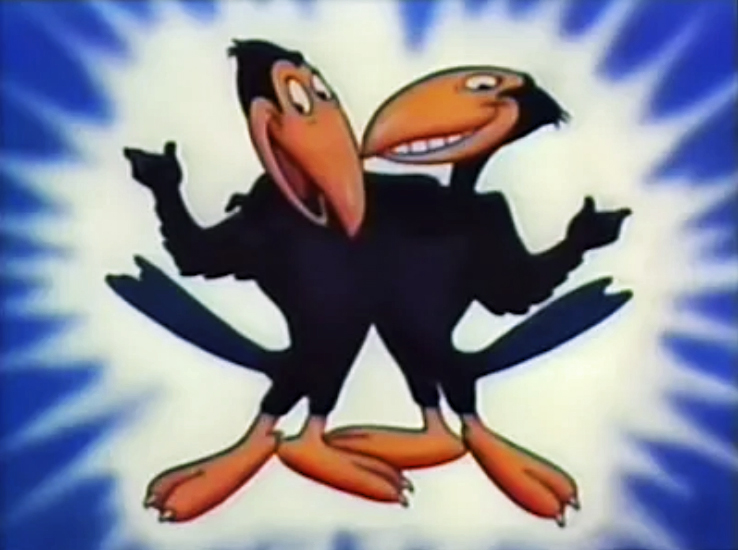 indistinguishable visually and discernable only by virtue of
their distinctive voices, one a refined British accent and the other a savvy
Brooklynese. The pair is also cheerfully violent and cruel, possessed of the
ability to manipulate the very fabric of reality itself, and perfectly well
aware of their existence as cartoon characters. In “The Power of Thought,”
the magpies observe that “we cartoon characters can have a wonderful life if
we only take advantage of it,” which of course they then proceed to do with
a series of increasingly weird sight gags wreaking mayhem on an unfortunate,
cognitively-disadvantaged bulldog police officer. indistinguishable visually and discernable only by virtue of
their distinctive voices, one a refined British accent and the other a savvy
Brooklynese. The pair is also cheerfully violent and cruel, possessed of the
ability to manipulate the very fabric of reality itself, and perfectly well
aware of their existence as cartoon characters. In “The Power of Thought,”
the magpies observe that “we cartoon characters can have a wonderful life if
we only take advantage of it,” which of course they then proceed to do with
a series of increasingly weird sight gags wreaking mayhem on an unfortunate,
cognitively-disadvantaged bulldog police officer.
The ambiguous nature of the two principals in
Heckle and Jeckle
combined with the arbitrary mindlessness of the violence and the bizarrely
conceived action to summon a richly equivocal experience unlike anything
else in the history of cartoons. A superlative example can be found in “King
Tut’s Tomb,” one of the most remarkable cartoon shorts ever produced.
Apparently bored with antagonizing their adversaries at home, the magpies
decide to fly a magic carpet to Egypt to seek treasure and annoy the sprits
lurking in the famous pharaoh’s tomb. I mean, why not? What follows is a
matchless sequence of craziness and spooky imagery culminating in a surreal
harem-cat dance number featuring appearances by Harpo Marx and
Frankenstein’s monster. Harpo’s cameo is probably a fond nod to the
undeniable influence of the Marx Brothers on the magpie’s raucous
shenanigans, as his presence serves no other conceivable purpose whatsoever.
Why Frankenstein shows up though is anybody’s guess.
Heckle and Jeckle
is a masterfully funny, entertaining, and skillfully rendered cartoon
series, but I think the sheer weirdness of their adventures is what appealed
most to me.
The Heckle and Jeckle
Cartoon Show aired on CBS
Saturday mornings until 1966 and then reappeared from 1969-71 on NBC. The
program featured a choice sampling of the fifty-two theatrical Heckle and
Jeckle cartoons produced by Terrytoons between 1946 and 1966. I find it
incomprehensible that this unique and timeless cartoon has never seen an
official release on DVD. Get on with it, chum.
2.
Top Cat
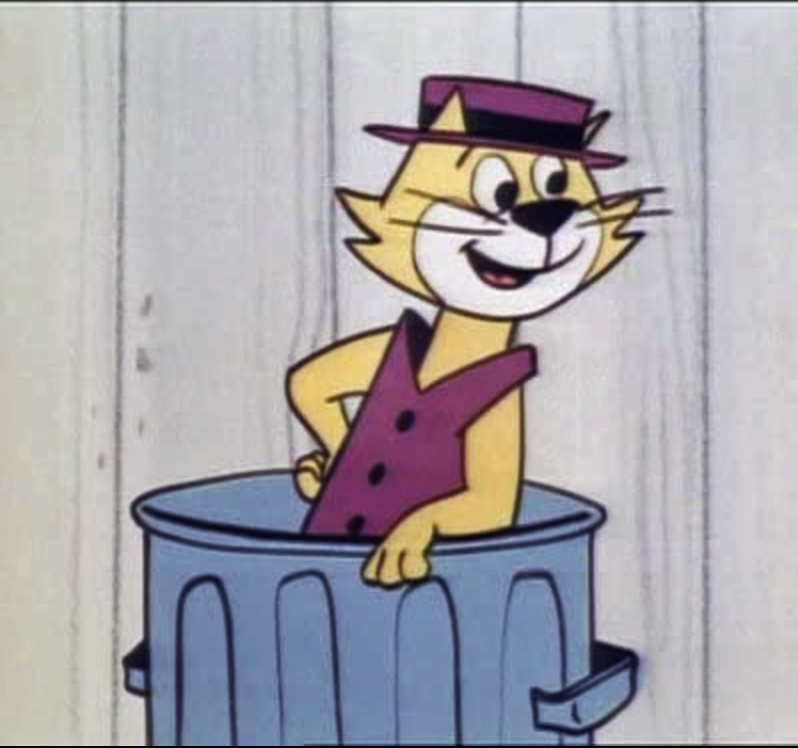 Top Cat is Hanna-Barbera at its most sublime; in hindsight a wry,
witty and exceptionally
sophisticated creation, even genuinely poignant at times. Top Cat is Hanna-Barbera at its most sublime; in hindsight a wry,
witty and exceptionally
sophisticated creation, even genuinely poignant at times.
The cartoon about the street-wise alley cat and his devoted gang of buddies
apparently found its inspiration in the Phil Silvers Show, much like
The Flintstones was based loosely upon The Honeymooners. Yet
Top Cat’s original model hardly accounts for the full splendor of
this clever animated jewel: Sgt. Bilko and his men were but a point of
departure and by no means the paradigm itself.
Top Cat and his pals are literally alley cats, denizens of a disreputable
but cozy Manhattan backstreet known as Hoagy’s Alley, which forms their home
and base of operations. TC is the acknowledged mastermind of the group and
he is perpetually seeking angles to exploit in order to improve his gang’s
lot in life. The show presents us with a tight-knot group of friends who
genuinely care about one another -- more than any other Saturday morning
cartoon, Top Cat consistently emphasizes the virtues of loyalty,
togetherness, and belonging.
Each of Top Cat’s
five cohorts has a distinctive shape, color, and personality, lending a
richness and variety to the storylines: the amorous Fancy-Fancy, the hip
beatnik Spook, the sensitive intellectual Choo-Choo, the ironically named
Brain, and Top Cat’s primary sidekick, the good-natured and conscientious
Benny the Ball. The city backdrop of the bustling streets and skyscrapers of
New York City was an unusual setting for a cartoon of this era and also lent
Top Cat its own unique flavor.
The
scheming Top Cat is certainly something of a scoundrel, but his
extraordinarily good-natured charm and quick humor makes him one of the most
beloved cartoon characters ever conceived. He is opposed by the seemingly
strict and perpetually annoyed beat cop Officer Dibble, who keeps a close
eye on all the feline mischief but is ultimately the cats’ best buddy in the
neighborhood. Top Cat and Dibble together present a central trope of the
cartoon – seemingly adversaries, the pair consistently exhibits mutual
affection and support.
Amid all the clever
one-liners, sight gags and inspired hucksterism, Top Cat could
suddenly turn quite touching. The pathos of the episode “A Visit from
Mother” derives from the loving relationship between Benny the Ball and his
mom, who has oddly come to believe that Benny is the mayor of New York
(because Benny wrote and told her he was). When mom comes to town for a
visit, the loyal Top Cat comes to Benny’s rescue with an elaborate scheme
that is not about making money but rather preserving his friend’s happiness.
In the end, TC convinces Benny’s mom that her son is indeed the mayor, only
to have her tenderly inform Benny that she would love him regardless of his
station in life. Top Cat exhibits a potent sentimentality that sets
it apart from its Saturday morning brethren.
Like a handful of Saturday morning ‘toons that includes The Jetsons
and Jonny Quest, Top Cat had its original run in prime time.
Sadly, the show failed to garner stellar ratings and lasted but a single
season, resulting in a total of only thirty episodes produced. Yet those
mere thirty shows found great success and longevity running endlessly on
Saturday mornings throughout the ‘60s and beyond, and just never did get
old. Echoes of the show can even be discerned in later children’s
programming: Top Cat perfected the art of trash-can living long before the
motif was employed with a certain Grouch on Sesame Street.
This heartfelt and brilliantly executed cartoon was Hanna-Barbera’s
masterpiece in my ever-so-humble opinion. He’s the most tip top!
1. The Bugs Bunny Show
There should
be very little surprise which Saturday morning cartoon snags the top slot.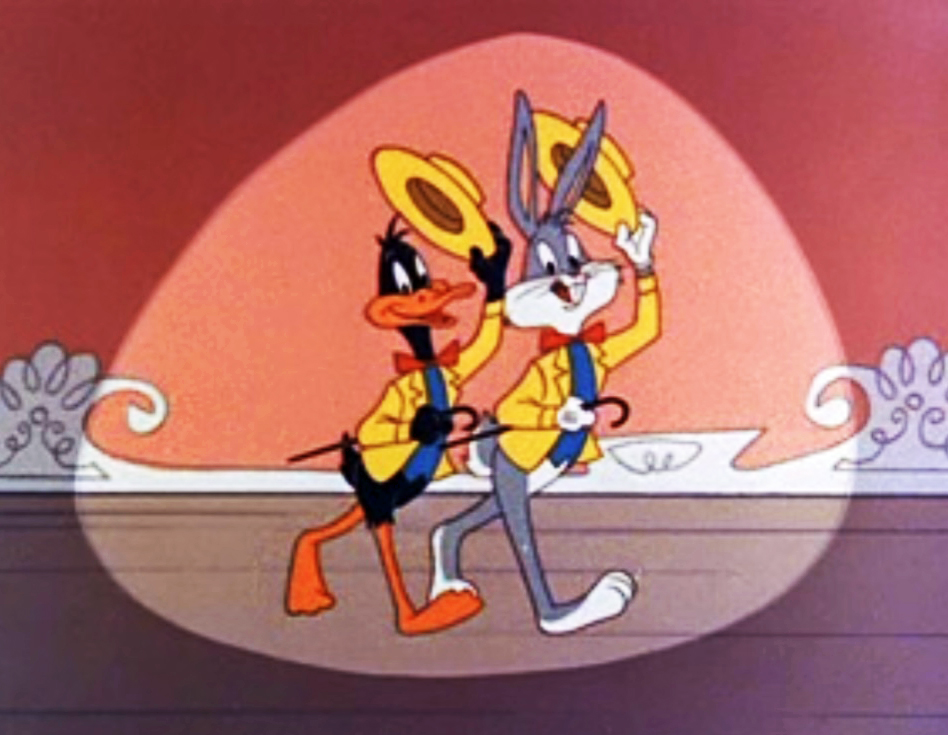
It would be quite impossible in a few short paragraphs to convey the
staggering cultural and artistic significance of Bugs Bunny. This singular
animated character, originally conceived as a simple zany goofball, quickly
evolved into a highly sophisticated and formidable cartoon everyman. Going
about his business, Bugs is content to leave others be until provoked, and
this is a key point: the mayhem he unleashes upon his adversaries is always
richly deserved. Over the years, Bugs morphed into a genuine cultural icon,
achieving success for an animated creation rivaled only by Disney. He wasn’t
introduced each week as "that Oscar winning rabbit" for nothing.
In the context of the Saturday morning cartoon milieu,
The Bugs Bunny Show
presented a wonderful framing for a dazzlingly rich archive of classic
Warner Brothers animated gems. The program was essentially an anthology
series composed of old Looney Tunes and Merrie Melodies shorts produced by
Warner Brothers for theatrical release over the previous two decades. Newly
created transition segments were prepared for each episode by the Warner
Bros. animation staff led by the legendary Chuck Jones and Friz Freleng,
ingeniously instilling the show with a charming continuity and cohesiveness.
Hosted by Bugs with the ever-problematic assistance of his pal Daffy Duck,
the show opened each week with the pair onstage wielding hats and canes and
singing the sprightly iconic theme song “This is It.” For the final chorus,
Bugs and Daffy are joined by a lively procession that introduces featured
supporting
characters including Tweety, Sylvester, Speedy Gonzales, Elmer Fudd, Pepé Le
Pew, Foghorn Leghorn, and my personal favorite, the exquisitely hapless and
immeasurably ornery Yosemite Sam.
After a couple
years in prime time, The Bugs Bunny Show debuted on Saturday mornings
on April 7, 1962 and became the longest continuously-running morning kid’s
show in TV network history. These amazing cartoons were the glue that held
Saturday mornings together, providing a bedrock foundation for everything
else that was going on. The timeless beauty of Bugs luring the maliciously
avaricious Daffy into spectacular feats of self-destruction is pure magic.
Tweety cheerfully and effortlessly destroying the determined Sylvester,
Foghorn’s ingenious battles with Barnyard Dawg, Elmer Fudd’s inept grasp of
duck season vs. rabbit season; countless examples abound. These cartoons
will endure forever.
Bugs Bunny is simply
transcendent artistry -- one of those glorious, unexplainable, intangible
and visionary concoctions that make life worth living.

My beloved
birthday cake, revised
By J. Bueker
I was saddened by Nabisco’s recent decision to discontinue their
iconic Famous Chocolate Wafer cookies, a fixture on American grocery store
shelves for well-nigh a century. Those chocolatey marvels became an integral
feature of my childhood birthdays by virtue of my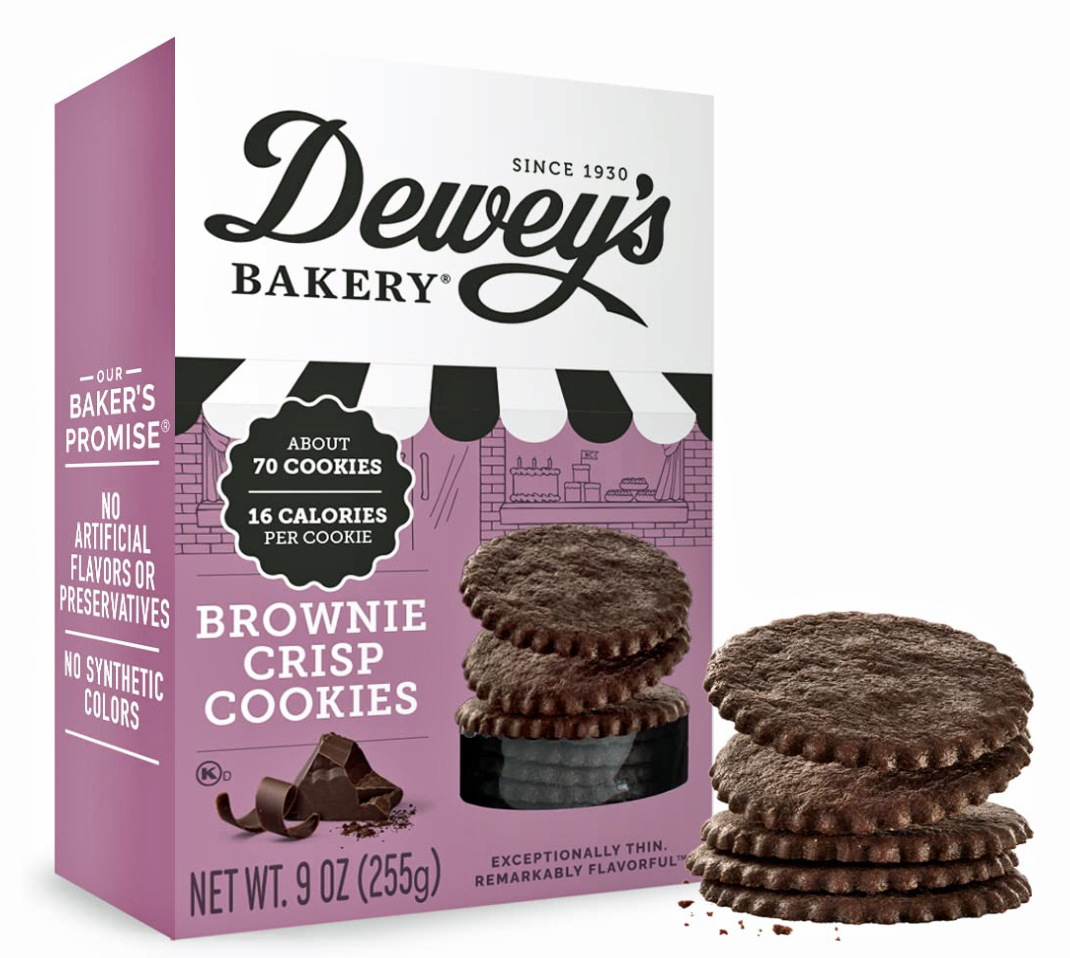 mother’s fondness for a
popular Wafer recipe: the Refrigerator Roll, also known as the Icebox Cake.
Somewhere along the way, this ambrosial whipped-cream-lathered creation
became my official birthday cake each year when I was a kid, and my wife has
kindly perpetuated the tradition for me into the twenty-first century. mother’s fondness for a
popular Wafer recipe: the Refrigerator Roll, also known as the Icebox Cake.
Somewhere along the way, this ambrosial whipped-cream-lathered creation
became my official birthday cake each year when I was a kid, and my wife has
kindly perpetuated the tradition for me into the twenty-first century.
So for my birthday this year, some difficult decisions needed to be taken. I
managed to locate a sparse selection of the Nabisco Wafers still available
online, but they were predictably outrageously overpriced as well as
significantly past their “Best Used By” date. After some soul-searching and
considerable painstaking research, we settled upon an acceptable replacement
cookie for the Refrigerator Roll: Dewey's Bakery Brownie Crisp Cookies.
I was quite unacquainted with the Dewey’s brand, which originated in North
Carolina in 1930, but the cookies were easy enough to locate and happily
proved to be an eminently serviceable substitute for the Famous Wafers.
Slightly smaller and presenting a somewhat different texture than the
Nabisco Wafer, Dewey’s thins are nonetheless equally delicious and perfectly
suitable for the legendary dessert roll. Birthday crisis averted!
The key to proper execution of this simple yet scrumptious recipe lies in
the provision of a decidedly generous apportionment of whipped cream layered
between each cookie. Don’t be stingy! Please also note that sugar should not
be added in the preparation of the cream, as the cookies alone provide the
perfect degree of sweetness for the dessert. Party like it’s 1968!
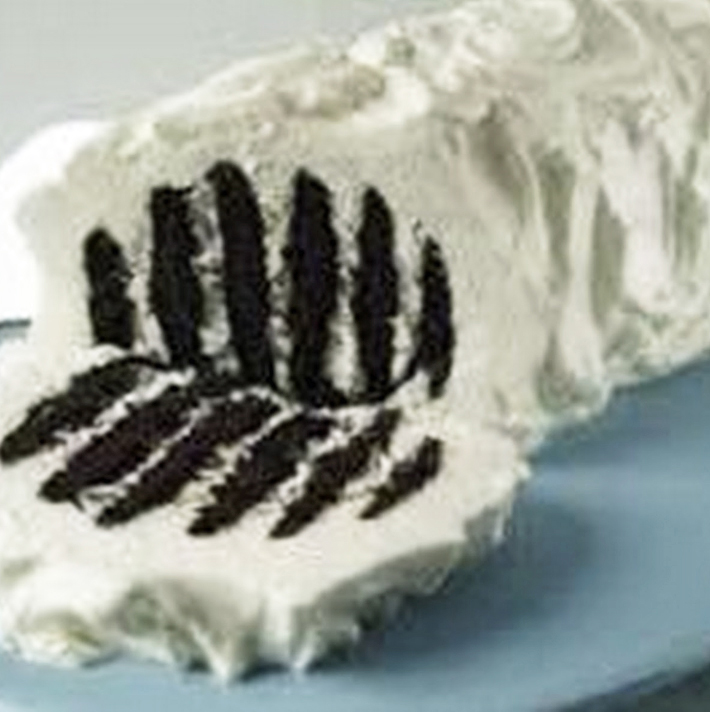
Famous Wafer Refrigerator Roll
(Revised)
Ingredients:
·
2
cups heavy whipping cream
·
1
teaspoon vanilla
·
1
package (9 ounces) Dewey's Bakery Brownie Crisp Cookies
Preparation:
·
Beat cream with mixer on high speed until stiff peaks form. Gently stir in
vanilla flavoring.
·
Spread 1-1/2 teaspoons whipped cream onto each cookie thin. Stack cookie
thins and then stand edge on platter. Frost with remaining cream. Chill
4 hours and serve.
Nutrition
Facts:
One serving
(3.5 oz / 100g) of Refrigerator Roll Cake has 294 calories (176 calories
from fat), 19.5g total fat (11.5g Saturated fat), 66mg cholesterol, 153mg
sodium, 109mg potassium, 24g total carbohydrates (14g sugar), and 6.9g
protein.
_________________________________________________________________________________________________________
JDA
Front Page
A1 /
Editorials A2 /
Nostalgia on the Avenue A3 /
Crossword
A5
|


 prophetic. The show seems to anticipate with remarkable
prescience such current technologies as housekeeper robots, personal video
conferencing, tablet computers, smart watches, holograms, and ubiquitous
giant flat-screen TVs, to name but a few. Yet despite its extraordinary
high-tech futuristic setting,
prophetic. The show seems to anticipate with remarkable
prescience such current technologies as housekeeper robots, personal video
conferencing, tablet computers, smart watches, holograms, and ubiquitous
giant flat-screen TVs, to name but a few. Yet despite its extraordinary
high-tech futuristic setting,  indistinguishable visually and discernable only by virtue of
their distinctive voices, one a refined British accent and the other a savvy
Brooklynese. The pair is also cheerfully violent and cruel, possessed of the
ability to manipulate the very fabric of reality itself, and perfectly well
aware of their existence as cartoon characters. In “The Power of Thought,”
the magpies observe that “we cartoon characters can have a wonderful life if
we only take advantage of it,” which of course they then proceed to do with
a series of increasingly weird sight gags wreaking mayhem on an unfortunate,
cognitively-disadvantaged bulldog police officer.
indistinguishable visually and discernable only by virtue of
their distinctive voices, one a refined British accent and the other a savvy
Brooklynese. The pair is also cheerfully violent and cruel, possessed of the
ability to manipulate the very fabric of reality itself, and perfectly well
aware of their existence as cartoon characters. In “The Power of Thought,”
the magpies observe that “we cartoon characters can have a wonderful life if
we only take advantage of it,” which of course they then proceed to do with
a series of increasingly weird sight gags wreaking mayhem on an unfortunate,
cognitively-disadvantaged bulldog police officer. Top Cat is Hanna-Barbera at its most sublime; in hindsight a wry,
witty and
Top Cat is Hanna-Barbera at its most sublime; in hindsight a wry,
witty and 

 mother’s fondness for a
popular Wafer recipe: the Refrigerator Roll, also known as the Icebox Cake.
Somewhere along the way, this ambrosial whipped-cream-lathered creation
became my official birthday cake each year when I was a kid, and my wife has
kindly perpetuated the tradition for me into the twenty-first century.
mother’s fondness for a
popular Wafer recipe: the Refrigerator Roll, also known as the Icebox Cake.
Somewhere along the way, this ambrosial whipped-cream-lathered creation
became my official birthday cake each year when I was a kid, and my wife has
kindly perpetuated the tradition for me into the twenty-first century.